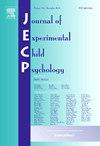儿童和成人的社会伴侣选择受到统计信息的不同影响
IF 1.8
2区 心理学
Q3 PSYCHOLOGY, DEVELOPMENTAL
引用次数: 0
摘要
目前的研究调查了美国成年人(N = 99)和5岁和6岁的儿童(N = 112)在选择社交伴侣时如何使用统计信息。我们发现,儿童在选择伴侣时综合了基本比率信息(群体内特征的分布)和个人层面的统计信息(个人过去行为的频率),而成年人只依赖于个人层面的统计信息,而忽略了基本比率信息。此外,成人和儿童也受到非统计信息的影响:成人在伴侣选择中表现出寻求风险和规避风险的倾向,而儿童在伴侣选择中只表现出寻求风险的倾向。这些发现证明,统计信息和非统计信息都会影响社会决策,成人和儿童以不同的方式受到每种信息的影响。目前的研究表明,未来的方向是进一步研究统计学习在我们的社会认知中的作用,并建立一个统一的账户,说明在我们的社会决策中,非统计信息如何与统计信息相互作用。本文章由计算机程序翻译,如有差异,请以英文原文为准。
Children’s and adults’ social partner choices are differently affected by statistical information
The current study investigated how U.S. adults (N = 99) and 5- and 6-year-old children (N = 112) use statistical information in their social partner choices. We found that children integrated base rate information (the distribution of traits within groups) and individual-level statistical information (the frequency of an individual’s past behaviors) in their partner choices, but adults only relied on the individual-level statistical information and neglected base rate information. In addition, adults and children were affected by non-statistical information: Adults showed risk-seeking and risk-averse tendencies, and children showed only risk-seeking tendencies in their partner choices. These findings provide evidence that both statistical and non-statistical information affect social decisions, and adults and children are influenced by each type of information in distinct ways. The current study suggests future directions to further investigate the role of statistical learning in our social cognition and to develop a unifying account of how non-statistical information interacts with statistical information in our social decisions.
求助全文
通过发布文献求助,成功后即可免费获取论文全文。
去求助
来源期刊

Journal of Experimental Child Psychology
Multiple-
CiteScore
4.50
自引率
7.70%
发文量
190
期刊介绍:
The Journal of Experimental Child Psychology is an excellent source of information concerning all aspects of the development of children. It includes empirical psychological research on cognitive, social/emotional, and physical development. In addition, the journal periodically publishes Special Topic issues.
 求助内容:
求助内容: 应助结果提醒方式:
应助结果提醒方式:


